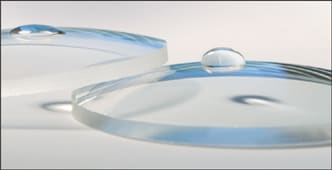troubleshooting tips
AR Spoilage Solutions
by Karlen McLean, ABOC, NCLC

Super-hydrophobic lenses need special treatment during edging. Image courtesy of Polycore
As the anti-reflective lens market grows, so does the demand for high-performing AR products like superhydrophobic, easy-to-clean AR.
On the consumer side, super-hydrophobic AR is a dream come true. But on the production side, it can cause redos that impact a lab's bottom line. Here, experts offer spoilage solutions.
BREAKAGE MY HEART
"There is increased breakage with super-hydrophobic AR lenses," says Stuart Kosh, president of Kosh Ophthalmic, Inc., in Pompano Beach, Fla. Slipperiness can cause crazing, twisting, and slipping during edging, but Kosh says reducing edging pressure, trying a different chuck, using a slow cycle speed, and trying different types of leap pads can help cut redos. "Also check the torque of the machine," he advises.
Danny Pugh, president of Optical Prescription Lab in Pelham, Ala., agrees. "Our most common problem with AR is slippage during edging." The lab uses three different types of pads that are designed specifically for super-hydrophobic AR lenses.
For the best super-hydrophobic processing results, look to the latest AR-capable edging equipment and rely on trained technicians who understand the intricacies and programming of each unit.
| Quick Tips |
|---|
| Super-hydrophobic AR lenses should be treated with the same care as specialty lenses, especially during edging. Following are the top tips for spoilage prevention according to Sean Tice, quality services manager with Satisloh. ■ Take off (machine speed start-up) slowly. ■ Cut less initially. ■ Specify the proper lens setting. ■ Take the time! Take it slow! Consider first and carefully carry out each step as you go. ■ Follow product recommendations. Most AR products are shipped with handouts that detail best practices. |
"It pays to invest in new, state-of-the-art equipment when processing super-hydrophobic AR," Kosh says. "Each edger has its own quirks; programming must be done frequently and maintenance should be performed as scheduled by the manual."
There are many factors that go into successful AR adherence and longevity, especially how the coating merges with the lens material.
"There are certain types of coatings we provide that adhere better than others depending on the lens manufacturer and initial backside coating," says Gordon "Scotty" Scott, Jr., vice president of Robertson Optical Laboratories' Columbia, S.C. facility. "Although Robertson is still able to provide quality AR coatings on lenses that have been previously ground, it's much better that the customer allows us to process the entire job." EB



